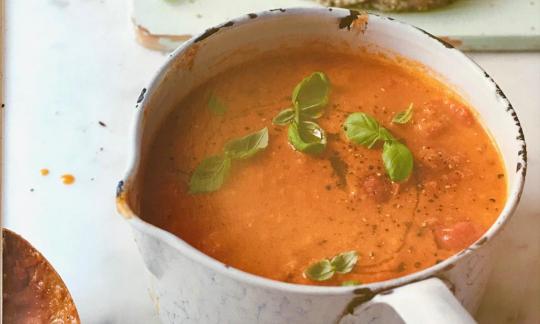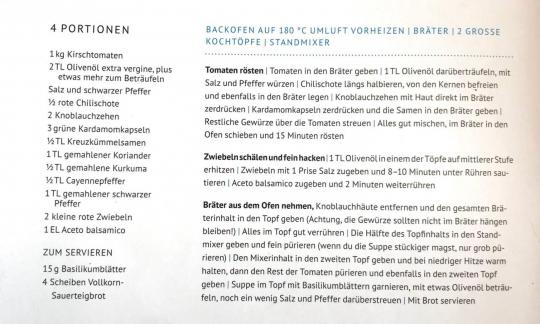Indian tomato soup with cardamom, cumin and turmeric
vegan
Ingredients (for servings, )
| For the soup base | |
|---|---|
| 1 kg | Cherry tomatoes, raw (cherry tomatoes, organic?) (35 oz) |
| 2 tsp | Rapeseed oil, refined (organic?) (0.32 oz) |
| Spices | |
| 1 dash | Table salt (table salt, raw?, organic?) (0.01 oz) |
| 1 dash | Black pepper (organic?, raw?) (0.00 oz) |
| ½ | Chili peppers, red, raw (organic?) (0.09 oz) |
| 2 cloves | Garlic (organic?) (0.21 oz) |
| 3 | Cardamom (cardamom, cardamom, cardamom) (0.02 oz) |
| ½ tsp | Cumin, seeds (raw, organic?) (0.04 oz) |
| 1 tsp, ground | Real coriander, seeds (raw?, organic?) (0.08 oz) |
| ½ tsp | Turmeric (saffron root), ground, raw (organic?) (0.05 oz) |
| ½ tsp | Cayenne pepper (raw?, organic?) (0.03 oz) |
| 1 tsp, ground | Black pepper (organic?, raw?) (0.08 oz) |
| 2 | Onions, red, raw (5.6 oz) |
| 1 tbsp | Balsamic vinegar (Aceto balsamico, raw?, organic?) (0.56 oz) |
| To serve | |
| ½ oz | Basil, fresh (organic?) |
Equipment
- blender or hand-held blender / immersion blender
- stove
- saucepan
- oven
- casserole dish (baking dish)
Type of preparation
- cook
- chop or grind
- sauté
- dry roast
- season to taste
- purée
- remove the skin
Preparation
roasting tomatoes
Put the tomatoes in the roasting pan (or casserole dish). Drizzle half of the oil over them, season with salt and pepper. Halve the chilli pepper, remove the seeds and also put it in the roasting pan. Crush the garlic cloves with the skin directly in the roasting pan. Crush the green cardamom pods and put the seeds in the roasting pan. Sprinkle the remaining spices over the tomatoes. Mix everything well, put the roasting pan in the oven and roast for 15 minutes.The original recipe uses olive oil instead of rapeseed oil. We deliberately used a different oil (see tips).
If you like it spicy, you can use the seeds of the chili pepper.
During the roasting process, proceed to step 2.
Peel the onions and chop finely. Heat the remaining half of the oil in a saucepan over medium heat. Add the onions with a pinch of salt and sauté for 8-10 minutes, stirring. Add the balsamic vinegar and stir for another 2 minutes.
Take the roasting pan out of the oven, remove the garlic skins and put the entire contents of the roasting pan into the pot. (Be careful, the spices shouldn't get stuck in the roasting pan!) Mix everything well in the pot. Put half of the contents of the pot into a blender and puree finely (if you like the soup chunkier, just puree roughly). Put the contents of the blender into a second pot and keep warm over a low heat.
In the original recipe, the authors also season the soup with a little olive oil.
Puree the rest of the tomatoes and add them to the second pot. Garnish the soup in the pot with basil leaves, season with a little salt and pepper and serve.
Optionally serve with bread - e.g. carrot-walnut bread or spelt bread.In the original recipe, the authors also season the soup with a little olive oil.
If the soup is served as a main course, bread is recommended as a side dish, as indicated by the authors.
|
Nutritional Information per person
Convert per 100g
|
2000 kcal | |
|---|---|---|
| Energy | 95 kcal | 4.7% |
| Fat/Lipids | 3.1 g | 4.4% |
| Saturated Fats | 0.30 g | 1.5% |
| Carbohydrates (inc.dietary fiber) | 16 g | 6.0% |
| Sugars | 9.0 g | 10.0% |
| Fiber | 4.4 g | 17.6% |
| Protein/Albumin | 3.1 g | 6.3% |
| Cooking Salt (Na:55.2 mg) | 140 mg | 5.8% |
| Essential micronutrients with the highest proportions | per person | 2000 kcal | |
|---|---|---|---|
| Vit | Vitamin C (ascorbic acid) | 40 mg | 49.0% |
| Vit | Vitamin K | 37 µg | 49.0% |
| Elem | Potassium, K | 708 mg | 35.0% |
| Min | Manganese, Mn | 0.62 mg | 31.0% |
| Vit | Folate, as the active form of folic acid (née vitamin B9 and | 48 µg | 24.0% |
| Min | Copper, Cu | 0.21 mg | 21.0% |
| Vit | Vitamin B6 (pyridoxine) | 0.28 mg | 20.0% |
| Vit | Vitamin A, as RAE | 120 µg | 15.0% |
| Elem | Phosphorus, P | 84 mg | 12.0% |
| Vit | Vitamin E, as a-TEs | 1.5 mg | 12.0% |
Detailed Nutritional Information per Person for this Recipe
The majority of the nutritional information comes from the USDA (US Department of Agriculture). This means that the information for natural products is often incomplete or only given within broader categories, whereas in most cases products made from these have more complete information displayed.
If we take flaxseed, for example, the important essential amino acid ALA (omega-3) is only included in an overarching category whereas for flaxseed oil ALA is listed specifically. In time, we will be able to change this, but it will require a lot of work. An “i” appears behind ingredients that have been adjusted and an explanation appears when you hover over this symbol.
For Erb Muesli, the original calculations resulted in 48 % of the daily requirement of ALA — but with the correction, we see that the muesli actually covers >100 % of the necessary recommendation for the omega-3 fatty acid ALA. Our goal is to eventually be able to compare the nutritional value of our recipes with those that are used in conventional western lifestyles.
| Essential fatty acids | per person | 2000 kcal |
|---|---|---|
| Alpha-Linolenic acid; ALA; 18:3 omega-3 | 0.18 g | 9.0% |
| Linoleic acid; LA; 18:2 omega-6 | 0.69 g | 7.0% |
| Essential amino acids | per person | 2000 kcal |
|---|---|---|
| Tryptophan (Trp, W) | 0.02 g | 10.0% |
| Threonine (Thr, T) | 0.08 g | 9.0% |
| Phenylalanine (Phe, F) | 0.09 g | 6.0% |
| Isoleucine (Ile, I) | 0.06 g | 5.0% |
| Lysine (Lys, K) | 0.10 g | 5.0% |
| Leucine (Leu, L) | 0.09 g | 4.0% |
| Valine (Val, V) | 0.07 g | 4.0% |
| Methionine (Met, M) | 0.02 g | 2.0% |
| Vitamins | per person | 2000 kcal |
|---|---|---|
| Vitamin C (ascorbic acid) | 40 mg | 49.0% |
| Vitamin K | 37 µg | 49.0% |
| Folate, as the active form of folic acid (née vitamin B9 and | 48 µg | 24.0% |
| Vitamin B6 (pyridoxine) | 0.28 mg | 20.0% |
| Vitamin A, as RAE | 120 µg | 15.0% |
| Vitamin E, as a-TEs | 1.5 mg | 12.0% |
| Thiamine (vitamin B1) | 0.12 mg | 11.0% |
| Niacin (née vitamin B3) | 1.6 mg | 10.0% |
| Riboflavin (vitamin B2) | 0.07 mg | 5.0% |
| Pantothenic acid (vitamin B5) | 0.30 mg | 5.0% |
| Biotin (ex vitamin B7, H) | 1.6 µg | 3.0% |
| Essential macroelements (macronutrients) | per person | 2000 kcal |
|---|---|---|
| Potassium, K | 708 mg | 35.0% |
| Phosphorus, P | 84 mg | 12.0% |
| Magnesium, Mg | 40 mg | 11.0% |
| Calcium, Ca | 55 mg | 7.0% |
| Sodium, Na | 55 mg | 7.0% |
| Essential trace elements (micronutrients) | per person | 2000 kcal |
|---|---|---|
| Manganese, Mn | 0.62 mg | 31.0% |
| Copper, Cu | 0.21 mg | 21.0% |
| Iron, Fe | 1.5 mg | 11.0% |
| Zinc, Zn | 0.62 mg | 6.0% |
| Selenium, Se | 0.67 µg | 1.0% |
| Iod, I (Jod, J) | 0.76 µg | 1.0% |
| Fluorine, F | 7.1 µg | < 0.1% |
The Indian tomato soup gets its different and exciting flavor from the spices cardamom, cumin, turmeric and coriander.
Serving size: The dish is designed as a starter or main course for 4 people. If you serve the soup as a main course, we recommend, as recommended by the authors, serving wholemeal sourdough bread as a side dish.
Nutrient profile: According to GDA guidelines, one portion of this low-calorie soup covers more than half of the average daily requirement of vitamin C and vitamin K. The ratio of omega-6 to omega-3 fatty acids is 4:1, which is below the recommended maximum ratio of 5:1.
Cherry tomatoes: The terms cocktail tomatoes and cherry tomatoes are often used synonymously. This refers to the small tomatoes, which often taste sweeter than their larger counterparts.
Cardamom: Cardamom, which comes from India, is not only a very old spice, but is also one of the most expensive of its kind, along with vanilla and saffron threads. This is due, among other things, to the irregular and labor-intensive harvesting conditions. In addition to its frequent use in cooking, especially in Asian countries, it is also used for medicinal purposes. A distinction is made between black cardamom ( Amomum subulatum), which is generally used for preparing hearty and spicy dishes due to its bitter and earthy aroma, and green cardamom ( Elettaria cardamomum), which is preferably used as an ingredient in spice mixtures and desserts due to its sweet and spicy aroma. You need green cardamom for this recipe.
Cumin: Due to the similar name, there is often confusion between cumin and caraway. They are not closely related and also differ greatly in taste. Cumin is often used in Indian, Turkish and Greek cuisine.
Coriander seeds: Coriander seeds contain 60% of the oil contained in the plant. Among others, linalool and geraniol are particularly responsible for the pleasant smell of coriander seeds, which only becomes apparent after drying.
Turmeric: Turmeric, also known as yellow ginger or turmeric root, comes from South Asia and belongs to the ginger family. Fresh turmeric has a resinous, slightly burning taste; dried, as is often used in India, it tastes milder and slightly bitter. Turmeric is best stored in a dark place and not for too long, as otherwise the color and aroma will be lost.
Red onion: Red onions are edible onions just like yellow and white onions. However, their skin is much thinner than that of light varieties and their taste is finer and somewhat milder.
Olive oil versus rapeseed oil: Economic forces and lobbying have made olive oil a cult oil, although the omega-6 (LA) to omega-3 fatty acid (ALA) ratio is significantly higher than the recommended maximum ratio of 5:1. Compared to olive oil, rapeseed oil has several times the proportion of essential fatty acids, especially omega-3 fatty acids. Cold-pressed oils are not suitable in this case, as they should generally not be heated above 180 degrees Celsius. That is why we have opted for refined rapeseed oil.
You can find further information on this topic at the following link: Vegans often eat unhealthily. Avoidable nutritional errors .
Prepare your own vegan bread variant, e.g. carrot-walnut bread or spelt bread.





